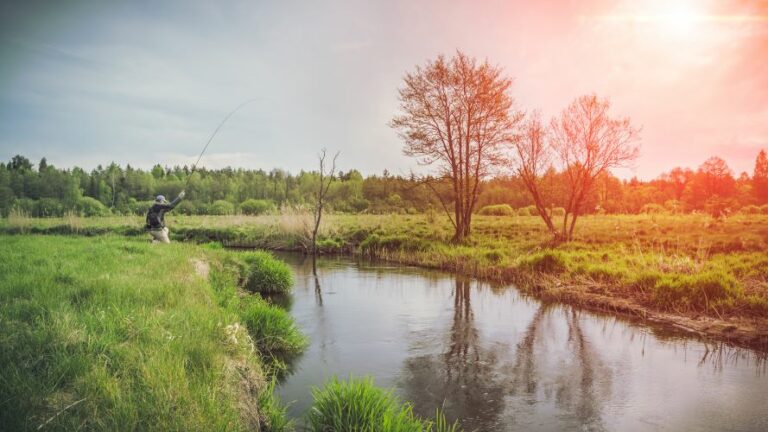Josh, our master roaster, can’t get enough of two things. Coffee and fly fishing. When you’re out standing in the river, nothing hits the spot quite like a steaming hot cup of coffee. With this in mind Josh set to work formulating the perfect coffee to enjoy while angling.
What Does Fly Fishing Have To Do With Coffee?
Enter: Gravel Bar Coffee. Made with a mix of medium-roasted and rich dark coffees, this blend is sure to please. Josh describes the flavour as “notes of cocoa and campfire, with a hint of roasted nuts.” Who could resist? Experience the taste of the great outdoors, anytime, anywhere with Gravel Bar Coffee. And if you’re curious about fly fishing at Cupper’s, we’ve got you covered! Let’s hit the rivers and start casting!

Brewing on the Go
Are you on the river and don’t have your favourite coffee maker with you? We have you covered. Pack along one of our amazing Gravel Bar Coffee brew bags! All you need is a mug and hot water and you can enjoy your Gravel Bar anywhere. These small brew bags are a practical and healthy alternative to instant coffee. We pack each sachet with nitrogen to keep your coffee as fresh as the day it’s packaged. To learn more about our brew bags and how they’re a game changer, check out our Ultimate Guide to Coffee Brew Bags.
What is Fly Fishing?
Fly fishing is a tranquil sport that’s perfect for coffee lovers who enjoy the great outdoors. It involves using a lightweight rod, line, and artificial fly to catch fish in rivers. Choosing the right fly is crucial for a successful catch, like your favorite coffee blend. Reading the water is key to understanding where fish might be hiding. Fly fishing is the perfect blend of tranquility and excitement. It’s perfect for when you want a peaceful escape or an adrenaline-fueled adventure. So, grab your gear and a cup of coffee, and let’s go!

Beginner's Guide To Fly Fishing
Get ready to experience the thrill of the catch and the peace of the great outdoors with fly fishing! This beginner’s guide will introduce you to the essentials of this dynamic sport. Fly fishing is where finesse and strategy meet the natural beauty of streams and rivers. You’ll learn all the secrets of successful fly fishing. And with our expert tips on choosing the right flies you’ll be reeling in your first catch in no time!
What Gear Do I Need for Fly Fishing?
At Cupper’s we carry a small assortment of fly fishing accessories. For a larger selection of equipment make sure to swing by Crowsnest Cafe & Fly Shop in Coalman, AB. They have a wide range of fly fishing gear to get you set up like a pro. (They also might know a thing or two about good spots to fly fish!)

To get started with fly fishing, you will need the following gear:
A Fly Fishing Rod
A fly rod is a specialized fishing rod designed for fly fishing. It is a lot lighter and thinner than a spin-fishing rod. Here are some important factors to consider when buying a fly fishing rod:
1. Length
2. Action
3. Line weight
4. Material
6. Comfort
A Fly Reel
A fly reel is the round bit used to store the fishing line and retrieve the fish you catch. When picking a fly fishing reel, consider what kind of fishing you’ll be doing and the size of fish you want to catch. Do you want to fish for big, powerful fish in saltwater or smaller fish in freshwater? Do you want a more traditional feel or the ability to adjust the drag?

Disc drag reels are great for saltwater and big fish, with a consistent drag and stopping power. Spring-and-pawl reels are perfect for freshwater and smaller fish. They have a lighter drag and a classic feel. So, take a look at your options and choose the one that’s right for you!
Fly Line
Fly lines come in various weights and lengths to match the type of fishing you’ll be doing. You need to match your line weight with your rod, or you’ll end up frustrated and fish-less. It’s hard to cast when the line weight is not matched to the rod you’re using.
Fishing Flies
Flies are artificial lures that mimic insects and other small prey that fish eat. Selecting the right kind of fly is crucial in fly fishing. Different flies trick the fish into thinking they’re eating their favourite food.
There are several styles of flies, and the type you use depends on what you’re fishing for:


Leader and Tippet
Leader and tippet attach the fly to the line. The leader and tippet are two separate components that work together to subtly deliver your fly to the fish. The leader is like the secret sauce that connects the fly line to the fly. It allows for a smooth and natural presentation. The tippet is the cherry on top that ties the fly to the leader with delicate precision.
Good fishers adjust the length and thickness of the leader and tippet to match the conditions. At Cupper’s, we have a range of tippets and leaders from Stroft always in stock. Experienced fishers know Stroft for it’s quality and reliability. Get ready to cast your line with confidence. Your leader and tippet will help you trick even the world-weariest of fish!
George Gehrke's Gink
George Gehrke’s Gink is the one and only floatant that has earned its place as the OG in the world of fly fishing. This liquid magic takes your dry flies to new heights. It makes them dance and glide effortlessly on the water like never before. Gink has a unique blend of silicone and secret ingredients. It transforms your flies into the ultimate decoys. It’s no wonder that this tried-and-true floatant has been the go-to for generations. So, get ready to elevate your fly fishing game with Gink. It’s the coolest and most effective floatant on the market – a must-have in every angler’s arsenal.

Voile Straps
One piece of equipment that can make all the difference are Voile Straps. These straps are the ultimate do-anything, fix-anything tool for all your outdoor needs.
Basic Casting Technique
Fly fishing is an exciting and fun activity that involves casting a line with a fly on the end to catch fish. The overhead cast is the most basic cast for fly fishing and is also a foundation for learning other casts.
To do the overhead cast, hold the rod like you’re shaking someone’s hand and pull out about 10 yards of line. Then, quickly flick your arm back to take the rod back. This causes the line to loop back behind you. Pause until the line is almost completely behind, then bring the rod forward to flick or cast the line out in front of you.
When practicing the overhead cast, it’s best to do so in open water or a field of grass. To avoid common mistakes, remember to pause until the line is behind you and to not use too much wrist motion. We think this video by Orvis Fly Fishing highlights this basic cast very well.
Where's the Best Fly Fishing in Southern Alberta?
Final Thoughts
Of course, the key to success in fly fishing is practice, practice, practice. Work on your casting technique until it’s as smooth as silk. Then dive into the different types of flies and tying methods. Know your fish – study their behaviors and habitats, and you’ll be well on your way to becoming a pro.

So why wait? Let fly fishing reel you in and take you on a journey like no other. Get ready to cast off into a world of excitement, challenge, and pure outdoor bliss. Grab your cup of coffee, get your gear and let’s go fishing!




